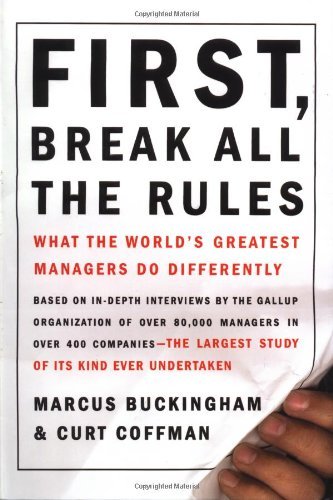First Break All The Rules (Marcus Buckingham, Curt Coffman)

Summary
“First, Break All the Rules” is a management book by Marcus Buckingham and Curt Coffman. The book is based on extensive research conducted by the Gallup Organization, which studied over 80,000 managers across different industries and organizations.
The authors argue that great managers do not follow conventional wisdom or best practices; instead, they break the rules and create their own unique management style. They identified 12 critical questions that great managers ask themselves and their employees to create a high-performing team. These questions include:
- Do I know what is expected of me at work?
- Do I have the materials and equipment to do my work right?
- At work, do I have the opportunity to do what I do best every day?
- Have I received recognition or praise for doing good work in the last seven days?
- Does my supervisor, or someone at work, seem to care about me?
- Is there someone at work who encourages my development?
- At work, do my opinions seem to count?
- Does the mission/purpose of my company make me feel my job is important?
- Are my co-workers committed to doing quality work?
- Do I have a best friend at work?
- Has someone at work told me about my progress in the last six months?
- Have I had opportunities at work this last year to learn and grow?
The authors also emphasize the importance of focusing on employees’ strengths rather than trying to fix their weaknesses. They argue that great managers help their employees develop their natural talents and abilities, which leads to higher engagement, productivity, and job satisfaction.
Overall, “First, Break All the Rules” provides a fresh perspective on management and offers practical advice for creating a high-performing team.
Takeaways
Chapter 1: The Measuring Stick
- The best managers focus on outcomes, not processes.
- The most effective way to measure results is through employee engagement.
- Employee engagement is the extent to which employees are emotionally invested in and committed to their work and organization.
Chapter 2: The Myth of the Well-Rounded Employee
- The best managers don’t try to make their employees well-rounded.
- Instead, they focus on developing their employees’ strengths and managing their weaknesses.
- The most successful employees can use their strengths to achieve their goals.
Chapter 3: The Art of Selecting Talent
- The best managers are skilled at selecting people for the right roles.
- They focus on hiring for talent, not just experience or skills.
- Talent is a natural way of thinking, feeling, or behaving that can be applied productively.
Chapter 4: The Power of the Right Fit
- The best managers understand that the right fit between an employee and their role is critical to success.
- They focus on finding the right fit by understanding the employee’s strengths and the role’s requirements.
- When employees are in roles that fit their strengths, they are more engaged and productive.
Chapter 5: The Art of Setting Expectations
- The best managers are skilled at setting clear expectations for their employees.
- They focus on setting expectations around outcomes, not just activities.
- Clear expectations help employees understand what is expected of them and how to succeed.
Chapter 6: The Role of Feedback
- The best managers provide regular feedback to their employees.
- They focus on providing specific, timely feedback and focus on the employee’s strengths.
- Feedback helps employees understand how they are doing and how they can improve.
Chapter 7: The Need for Recognition
- The best managers understand the importance of recognizing their employees’ achievements.
- They focus on providing recognition that is personal, timely, and meaningful.
- Recognition helps employees feel valued and motivated to continue performing at a high level.
Chapter 8: The Importance of Development
- The best managers are committed to developing their employees.
- They focus on developing their employees’ strengths and managing their weaknesses.
- Development helps employees grow and become more effective in their roles.
Chapter 9: The Role of the Manager
- The best managers understand that their role is to facilitate their employees’ success.
- They focus on providing the resources and support their employees need to be successful.
- Effective managers create a positive work environment that fosters engagement and productivity.
Chapter 10: The Need for Engagement
- The best managers understand that employee engagement is critical to success.
- They focus on creating a work environment that fosters engagement.
- Engaged employees are more productive, committed, and likely to stay with their organization.
Overall, the key takeaway from the book is that the best managers focus on developing their employees’ strengths, creating a positive work environment, and fostering employee engagement. By doing so, they can achieve better outcomes and create a more successful organization.